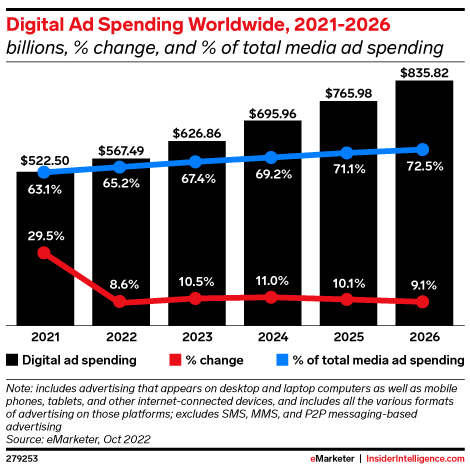Programmatic advertising is a game-changing innovation in the ever-evolving digital marketing landscape. This automated approach to purchasing advertising space represents a fundamental departure from traditional manual methods. Fueled by automated bidding processes driven by cutting-edge machine learning and AI algorithms, programmatic advertising ensures that ads are delivered and strategically placed at the right moment and in front of the right audience.
Exploring the Potential of Audio Programmatic Advertising
Programmatic advertising is the encompassing term for the comprehensive processes that facilitate the acquisition of impressions via automated systems, significantly reducing human involvement and the cumbersome manual insertion of orders. While programmatic advertising has long been the linchpin of online advertising, it is now expanding its reach into novel domains such as radio and audio advertising, out-of-home (OOH) advertising, and even the realms of traditional print media.
Specifically, programmatic audio represents the utilisation of technology to automate the sale and insertion of advertisements within audio content, spanning various formats like podcasts, digital radio, and music streaming services.
Given the resounding success it has achieved in other advertising realms, it is undeniably evident that programmatic audio boasts substantial potential. The primary barriers impeding its progress in past years were the limited interest from publishers and the absence of robust technology and standards necessary to facilitate its adoption.
As we observe declining interest in conventional television, it becomes apparent that the impetus for transitioning to programmatic TV on over-the-top (OTT) devices has been the waning appeal of traditional TV. Novel technology solutions are facilitating a return to the days of out-of-home advertising with a digital twist, offering superior targeting, measurement, and retargeting capabilities. Much like the trajectory of TV and OOH, the diminished popularity of traditional radio is propelling the increased adoption of online and digital radio broadcasting.
In essence, programmatic advertising forms the bedrock of ad technology, revolutionising the media buying and selling landscape by harnessing data-driven automation. Advertisers leverage programmatic advertising’s prowess to achieve pinpoint precision in their targeting efforts, optimise advertising expenditures, and maximise their return on investment (ROI).
At the heart of programmatic advertising lies the indispensable role of machine learning and artificial intelligence (AI). These groundbreaking technologies empower marketers with large-scale predictive analytics, audience segmentation, and content personalisation. AI-driven platforms continuously fine-tune ad campaigns to enhance performance and deliver users more relevant content.
Digital advertising evolves
As the digital marketing landscape evolves, audio programmatic is emerging as a substantial component of programmatic advertising. In an era where podcasts, streaming services, and voice-activated devices are becoming integral to daily life, audio programmatic’s growth is remarkable.
According to eMarketer, digital ad spending worldwide growth has decelerated precipitously but will reach 10.5% year over year in 2023, achieving $626.8 billion. The slower new normal will still entail double-digit annual increases over the coming years and is predicted to reach $835.82 billion in 2026.

Considering the success it’s had in the other areas of advertising, there is no doubt programmatic audio has enormous potential. The only thing that has held it back for so many years is the limited interest of publishers and the lack of proper technology and standards to provide it.
Digital audio ad spending in the United States is estimated to reach $6.31 billion in 2022, up 10.8% year-on-year from 2021. Programmatic is set to represent $1.31 billion of that ad spend, increasing to $1.8 billion in 2024 (eMarketer May 2022).
The global programmatic ad spending skyrocketed to $418 billion (£343 billion) in 2021. Projections suggest this figure will swell to a colossal $725 billion (£594 billion) by 2026. Programmatic advertising is not just a trend but an indispensable part of the modern marketing landscape.
Unveiling the Advantages
The surge in programmatic advertising’s popularity can be attributed to its advantages. These campaigns offer unparalleled scalability and flexibility, accommodating businesses of all sizes and industries. Speed and agility are woven into programmatic advertising’s DNA, courtesy of combining machine learning and AI, which elevates campaign performance.
Diverse Ad Placements
Through programmatic platforms, advertisers unlock access to various ad placements, encompassing native, display, video, connected TV (CTV), audio, in-game, and digital out-of-home (DOOH). These platforms collaborate with numerous exchanges, ensuring access to a vast network of websites and apps. This enables media buyers to reach their target audiences across various online environments.
Seamless Multichannel User Experience
One of programmatic advertising’s standout strengths is its capacity to provide users with a cohesive and seamless experience across various channels, including emerging ones. In a world where consumers constantly embrace new channels, adopting a mix of platforms becomes essential for marketers aiming to connect with their desired audience.
Industry-Specific Targeting Strategies
Three real-world examples illustrate the power of industry-specific targeting in programmatic advertising:
- B2B Brands: Efficient Retargeting for Long Sales Cycles
B2B marketers grappling with extended sales cycles benefit immensely from programmatic advertising. Video advertising, digital out-of-home (DOOH) ads, and audio ads emerge as standout channels for increasing brand and product awareness. These channels enable B2B brands to reach potential customers wherever they engage with online content.
- Travel Brands: Capturing Key Moments in the Customer Journey
In a world where travelers conduct extensive online research, programmatic advertising empowers travel brands to target audiences during pivotal moments in their journey. For instance, travelers attending events in different cities may need flights, hotels, or airport transfers. Intent-based audience segments and geotargeting effectively capture this niche audience. Native and display ads excel in showcasing options and deals.
- Retailers: Crafting a Multichannel Shopping Experience
Retail marketers face the unique challenge of bridging the digital-to-offline sales gap. A multichannel approach is crucial, leveraging channels like video and audio for awareness during prospecting. Retailers can then retarget users based on video or audio completion rates (VCR and LCR) with engaging channels like native and display to reinforce branding.
Navigating the Programmatic Advertising Landscape
Programmatic advertising unveils a world of possibilities for targeting hyper-relevant audiences in industry-specific campaigns. The myriad targeting options span from those reading about specific topics to visitors of competitor websites and individuals in physical locations. If you’re keen to explore audio programmatic advertising further, consider contacting AdTonos Programmatic Professionals.



